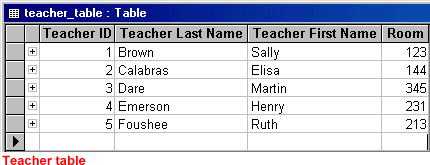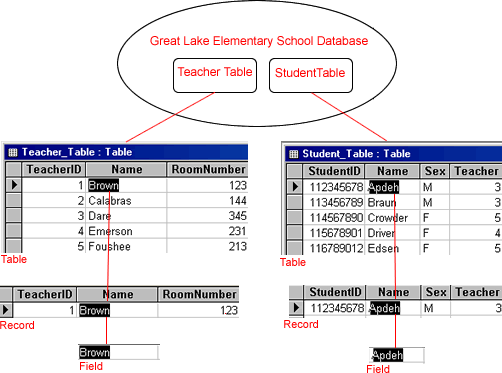
Access 2000
Database Terms
Introduction
Microsoft Access 2000 is a database application in the Microsoft Office Professional Suite (Developer and Professional versions).
By the end of this lesson, learners should be able to:
- Discuss basic database concepts
- Discuss basic database terms
What is a Database?
A database is a collection of information organized and presented to serve a specific purpose. Database programs are created using a program like Microsoft Access XP.
A Microsoft Access database is made up of several components including:
- Tables
- Forms
- Queries
- Reports
These components are called database objects. One or more of these objects are formed when a database is created. These components are stored in a single database file.

Database Terms
Data: Information such as numbers, text, date/time, and currency.
Database: A database is collection of all of an organization's data, and is organized into one or more tables. Access lets you organize information in separate, manageable units. Linked (or related) tables allow you to extract information based on certain criteria. Tables are linked by a common column (key).
 Example:
The Great Lake Elementary School Database stores information (data) necessary
for operating an elementary school. This information may include but is not
limited to teacher information and student information.
Example:
The Great Lake Elementary School Database stores information (data) necessary
for operating an elementary school. This information may include but is not
limited to teacher information and student information.

Database Terms - Tables, Records, Fields
Table: A table is made up of several records. A table contains data that describes one thing or individual. In a table, data are arranged in columns and rows in an essentially rectangular shape. (A spreadsheet, for example, looks like a table.)
 Example: There are several teachers listed in the Teacher Table. Each teacher is assigned a TeacherID, Name, and Room Number.
Example: There are several teachers listed in the Teacher Table. Each teacher is assigned a TeacherID, Name, and Room Number.

Record: A record is made up of several fields. A record includes all the data for a specific thing or individual.
 Example: All the data for a particular teacher is a record.
Example: All the data for a particular teacher is a record.

Fields: A field is a space allocated for a particular piece of information, located at the intersection of a row and column.
 Example: Mrs. Brown's name is Brown. Brown is contained in a field.
Example: Mrs. Brown's name is Brown. Brown is contained in a field.

 Click
next to view a graphic representation of the Great Lake Elementary School
Database.
Click
next to view a graphic representation of the Great Lake Elementary School
Database.
The Great Lake Elementary School Database - Tables, Records, Fields

Database Terms - Queries, Forms
Query: Data resulting from questions you ask of one or more tables.
 Example: Show me a list of the female students in Mr. Emerson's class.
Example: Show me a list of the female students in Mr. Emerson's class.


Form: A form is a graphical user interface used to enter (and view) data. Forms usually display one record at a time and contain blank fields, allowing easy data entry.
 Example:
A new student arrives at Great Lake Elementary School. Using a form, the administrative
assistant enters the student's information into the Great Lake Elementary
School Database. The new data is now stored in the database.
Example:
A new student arrives at Great Lake Elementary School. Using a form, the administrative
assistant enters the student's information into the Great Lake Elementary
School Database. The new data is now stored in the database.

Database Terms
Report: Presents data (stored in tables) in a formatted, organized summary suitable for printing.
 Example: A teacher wants to produce a student phone list.
Example: A teacher wants to produce a student phone list.

Challenge!
The best way to understand databases is to learn how to view the world and the things in it, and then think of structures that best serve to organize this information.
For example, think of your music collection in terms of a database. The database might be called music collection. What tables might be in this database?
- Do you have both CDs and tapes, or just tapes? Could this media type be an example?
- Do you listen to different styles of music? Could music style be a table?
- Do you listen to different musical artists? Could musical artists be a table?
- Do you have more than one recording for any artist? Could specific recordings be a table?
Here is your assignment:
- Using the questions above, outline a structure using those questions for which you answered "yes" (or any other questions that you might think of).
- List at least five items from your collection that could go into each category created in step #1. If your music collection is not large enough to list five items in each category, then think of artists that you know about and use this information as if you owned it.
- After completing step #2, the database has some information defined to it. What report might you want to print that tells you about some part of the information in the database?
This step, looking at the information to be categorized, is the first step toward designing a database.